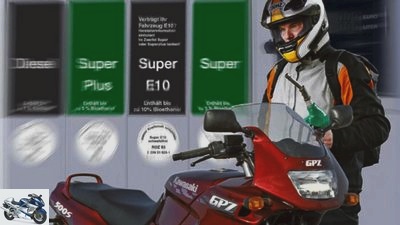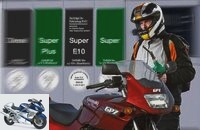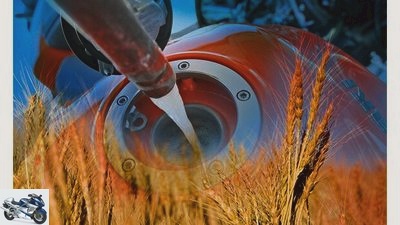Table of contents
- What does the new E10 fuel bring? Advantages and disadvantages of the ethanol fuel
- What is bioethanol and what does it cost?
- Who can not take it?

archive
counselor
workshop
Report: What does the new E10 fuel bring?
What does the new E10 fuel bring?
Advantages and disadvantages of the ethanol fuel
Super E10 is not for the Kawasaki GPZ 500. Like many other youngtimers and older motorcycles, it cannot handle fuel with ten percent ethanol, which has been flowing from specially marked pumps at German petrol stations since the beginning of 2011.
Berit Horenburg
02/17/2011
Until 2010, the types of gasoline in Germany contained up to five percent bioethanol, which motorcycles and cars can easily put away. As early as 2008, the federal government tried to implement the EU requirement for the introduction of fuels with E10 in Germany.
At that time, the increase to up to ten percent bioethanol failed due to the protests of angry motorists who feared damage to their treasures. The Federal Environment Ministry has now obliged fuel suppliers to continue to offer petrol that contains no more than five percent ethanol in addition to Super E10. And for an unlimited period of time. While the EU regulation provides that E5 fuel will be available until at least 2013, filling stations in Germany must also offer E5 fuel beyond that, as the Federal Environment Ministry explains.
Buy complete article

What does the new E10 fuel bring?
Advantages and disadvantages of the ethanol fuel
3 pages) as PDF
€ 2.00
Buy now
The situation in other European countries is unclear. The ADAC therefore advises not to fill up with E10 fuel abroad for the time being. “As long as different national fuel standards apply, this leads to partially different manufacturer approvals”, is the resume of the automobile club.
What is bioethanol and what does it cost?

archive
Flows into the tank: admixture of up to ten percent alcohol from grain.
Bioethanol is alcohol that is distilled from wheat, corn, beet or wood waste. The Federal Government and the European Union plan to implement effective climate protection. “We want to reduce the CO² emissions from car exhaust fumes and thus also protect the increasingly scarce oil reserves”, says Federal Environment Minister Norbert Rottgen. The addition of bioethanol reduces the dependency on oil, which is imported as a scarce commodity from politically unstable countries.
In addition, the proponents argue that the burning of plants that grow in Germany or Europe causes fewer greenhouse gases than fossil fuels. The federal government demands sustainability in a law: Ethanol should “Save a certain minimum amount of greenhouse gases compared to fossil fuels, taking into account the entire manufacturer and supply chain”, according to the Federal Environment Ministry. And 35 percent.
In addition, the areas on which plants for fuel may be grown are defined. What ends up in the tank and not on the table should relieve and not pollute the environment. However, critics do not believe in the environmental compatibility and improved carbon dioxide balance of the biofuel.
On the contrary: Manufacturing consumes more energy than the fuel ultimately releases. In addition, there are dangers such as overexploitation of nature through deforestation, pollution of the water supply, loss of cultivation areas for food and contamination of soils and water by fertilizers and pesticides.
Compared to fossil fuel, bioethanol has a lower energy value, which results in higher consumption. The Federal Environment Ministry also has an answer to this: “Driving behavior has a far greater influence on fuel consumption.” Possible damage Pure bioethanol attacks rubber and plastics because it dissolves the plasticizers contained in seals and hoses. The result: the material becomes brittle and leaks. At the moment, up to five percent ethanol is used rather little alcohol. The following rule of thumb applies: the higher the proportion, the less suitable the fuel is for unmodified vehicles that are not designed for ethanol.
“In the engine, all uncoated aluminum parts that come into contact with E10 fuel as well as fuel-carrying parts such as lines, pumps, seals and injection valves can be affected”, is the verdict of Hans-Walter Kaumanns from the German Association of Motor Vehicles. More wear is to be expected on valve seat inserts as well. Bioethanol has a corrosive effect. In many newer vehicles, fuel-carrying parts are therefore coated with Teflon.
The mineral oil industry is not yet committed. However, the E10 fuel requires new logistics, from the mixture in the refinery to separate transport to the extra fuel pump. That could make the new fuel more expensive.
But it would also be possible that the mineral oil companies want to convince as many customers as possible to fill up with E10 so that the companies can meet the quotas required by the federal government. The easiest way to do this would be through a low price. Which would mean that E5 fuel could get more expensive. According to the Federal Environment Ministry, E10 increases fuel consumption by around two percent.
Who can not take it?
The Central Association of the German Motor Vehicle Industry estimates that E10 will be incompatible with up to a million motorcycles. However, there is a lack of detailed knowledge: Kawasaki, for example, has not yet checked motorcycles before the 2006 model year.
The Italian manufacturers and their suppliers seem to have been taken completely by surprise. In any case, most of them are still checking whether and, if so, what is possible with E10.
Honda, on the other hand, lists almost every model and also recommends a look in the driver’s manual, chapter fuel. Many manufacturers agree that the use of E10 in carburettor models can lead to poor engine running behavior despite approval. “This not only relates to top performance, but also to performance and running culture”, so Kawasaki. “Unstable idle, poor response and engine ringing” enumerates Kawasaki. In such cases, the manufacturers advise not to fill up with E10 any more and to refill petrol with a lower proportion of ethanol, for example Super Plus.
Suzuki has also made a list of vehicles that can take E10. From 2002 onwards there are all of them. Basically, the E10 is also suitable for unlisted motorcycles from model years 1992 to 2001. “However, vehicles with more than five percent ethanol in the fuel may not be parked for a long period of time.” That should be impossible, especially in winter.
Honda warns that bio-fuel can attack painted surfaces on the tank and trim parts. KTM even recommends filling models built before 2000 with fuels that contain five percent or less ethanol. “Premium fuels such as Aral Ultimate 100 or Shell V-Power 100 will have the lowest possible ethanol content and should therefore be preferred for older vehicles.”
One thing is clear: refueling will be more expensive for fans of youngtimers. If you use the wrong fuel nozzle, you can actually do a lot. The Central Association of the German Motor Vehicle Industry therefore advises: “Anyone who accidentally refueled E10 in an unsuitable vehicle should have the tank pumped out immediately.” If you have any queries (see list), the manufacturers ask you to have the vehicle documents ready. Info: www.adac.de/e10, www.dat.de/e10

archive
Dr. Klaus Picard, General Manager of the Mineral Oil Industry Association in Germany, on E10 petrol.
“Irreversible damage caused by misfuelling”
From 2011, the petroleum companies will have to offer petrol at their filling stations that contains up to ten percent ethanol. Does this affect all petrol stations? What types will the gas stations offer?
In order to meet their legal obligations under the biofuel quota, the mineral oil companies have to add up to seven percent by volume of biodiesel to diesel and up to ten percent ethanol to gasoline. Failure to meet the quota leads to a heavy fine. For this reason, petrol will contain ten percent ethanol across the board at filling stations within the next year. The new fuel type is called “Super E10” excellent. At every petrol station that offers Super E10, there will also be super petrol with a maximum of five percent ethanol.
To what extent can filling stations also offer fuels that do not contain ethanol? Expensive premium products, for example?
As a lobby group, we cannot make any statements about this. The decision on the range of grades rests with the oil companies.
? According to EU guidelines, petrol stations that offer E10 should also offer E5 petrol by 2013. What happens after that?
The requirement to offer both E10 and E5 fuels by at least 2013 is part of the European directive. In the German ordinance, the obligation to also offer E5 petrol is not limited in time.
What is your advice to customers before they fill up with E10 for the first time?
Before customers fill up with Super E10 for the first time, they must check with the manufacturer of their vehicle to ensure that it can handle Super E10. According to the automobile manufacturers, just one misfuelling with Super E10 can irreversibly damage vehicles that cannot tolerate this fuel.
Related articles
-
What does the performance race bring?
Suzuki motorcycles What does the performance race bring? What does the performance race bring? Hard on the limiter Almost 30 years ago, the motorcycle…
-
Report: New or used – what does the market offer for around 5500 euros?
jkuenstle.de counselor Used purchase Report: New or used – what does the market offer for around 5500 euros? Report: New or used – what does the market…
-
Bilski motorcycles Shell specialty fuel Shell specialty fuel V-Power Regardless of the engine concept, Shell propagates an increase in performance of up…
-
Driving report KTM 1290 Super Adventure S.
News 2022 New motorcycle items for 2022 KTM 12th pictures KTM 1/12 Carelessness is mainly due to the extensive electronics package, which has been…
-
Driving report Aprilia Tuono 660: Small but powerful thunderstorm
News 2022 New motorcycle items for 2022 Aprilia 10 pictures Aprilia 1/10 With the Tuono 660 Aprilia wants to mix the naked bike middle class properly….
-
Driving report electric motorcycle eROCKIT
Package 12th pictures 1/12 Erockit 2/12 Erockit 3/12 Erockit 4/12 Erockit 5/12 Erockit 6/12 Erockit 7/12 Erockit 8/12 Erockit 9/12 Erockit 10/12 Erockit…
-
Driving report Neckarsulm motorcycle from 1902
motorcycles Driving report Neckarsulm motorcycle from 1902 Driving report Neckarsulm motorcycle from 1902 At the origin 1901 and 1903 – the beginning of…
-
Ducati Multistrada V4 S (2021) in the driving report
News 2022 New motorcycle items for 2022 Ducati 20th pictures Ducati 1/20 Ducati has achieved something amazing with the new Multistrada V4: a travel…
-
Driving report: Honda CBF 1000 F
Rudolph 10 pictures Rudolph 1/10 Even when the going is steep uphill, the CBF 1000 F pulls on without ceasing. Rudolph 2/10 Now adjustable: the spring…
-
Driving report Harley-Davidson Breakout
Photo: manufacturer 33 pictures manufacturer 1/33 Harley-Davidson Softail Breakout in the driving report. manufacturer 2/33 Harley-Davidson Softail…